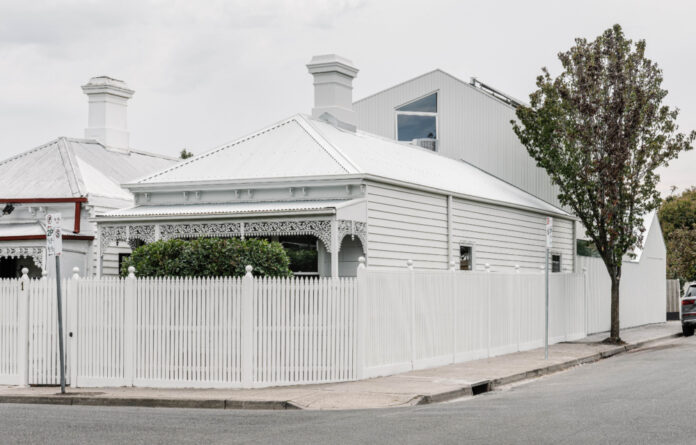An All-Electric + High Performing Worker’s Cottage
Sustainable Homes


A recent renovation has transformed this Victorian worker’s cottage to be energy-efficient and high-performing.

Homeowner Ben Jones and family.

The setback upper storey addition.

Where old meets new.

The new open-plan living domain downstairs.

Other sustainable features include three-phase electric car charger, double glazing, added insulation, and heat pumps for hydronic heating and hot water.

Stairs leading to the new upper storey.

The north-facing courtyard.

Main en suite.

The sleek and contemporary bathroom.

Ben’s home is now rented out to tenants who reap the rewards of living in an energy efficient rental property.
Ben Jones and his partner purchased a worker’s cottage in Prahran, Melbourne with a clear intent — to make it the highest-performing property possible.
‘Most importantly, we wanted to build a house that produced more energy than it needed to run itself and an electric vehicle,’ Ben says.
Achieving this goal wasn’t easy. The original home was cold and dark, and a heritage overlay restricted the upstairs roof size that limited the size of the solar system they could install.
The renovations saw the removal of previous additions, leaving only the two downstairs bedrooms and hallway behind the original facade.
A two-storey extension follows featuring an open-plan living domain that opens to a north-facing courtyard, with the main bedroom and en suite in the setback upper storey.
The interiors are pared back and timeless, comprising light timbers and white walls that instil the house with a sense of calm.
Post-renovation, the house features no gas appliances and produces a significant proportion of its own electricity via a 10kW solar system with a 12kW battery for storage.
Other features include three-phase electric car charger, double glazing, added insulation, and heat pumps for hydronic heating and hot water.
‘Using heat pumps for hydronic heating as well as hot water required more space than other systems… Sadly we have ended up with some equipment in the courtyard, [but] this could have been avoided with better planning and design,’ says Ben.
As a first time-renovator, Ben has learned a lot that he’s keen to share with fellow renovators. His first tip — choose a team who specialise in sustainable design.
‘We naively thought that all architects and builders would be focused on, and knowledgeable of, air tightness, insulation, solar production, storage and metering,’ Ben says.
He recommends involving an air tightness expert from the start of the design phase, such as Drew Kroker from Passivetech who was integral to the success of the project.
Ben’s home is now rented out to tenants who reap the rewards of living in an energy efficient rental property.
He adds, ‘I’m excited to take what we have learned and apply that knowledge to the renovation of our family home. Hopefully we’ve learned on a small scale and can use those learnings to make our family home a much greater success.’
thedesignfiles.wpenginepowered.com










